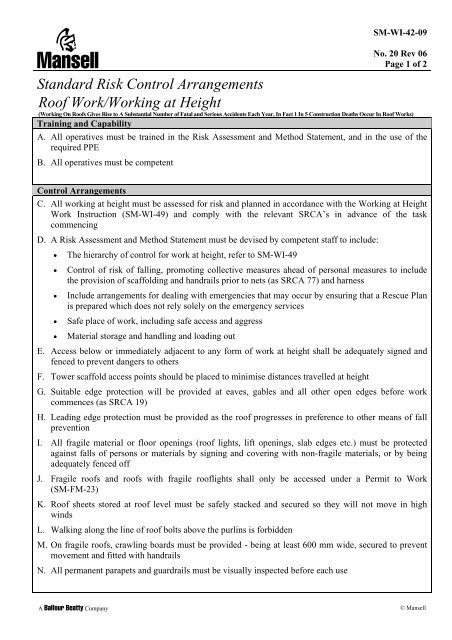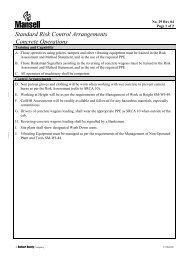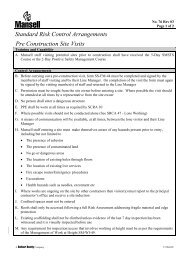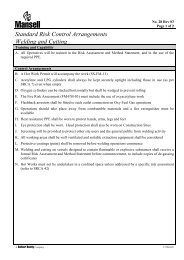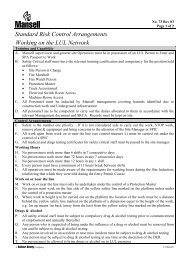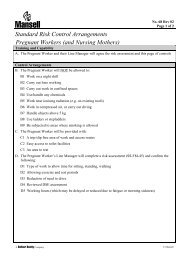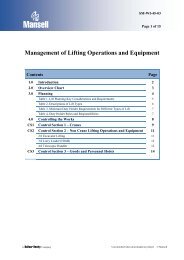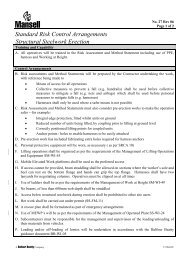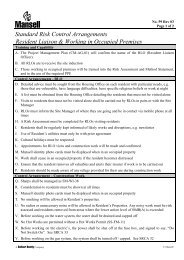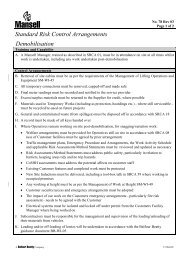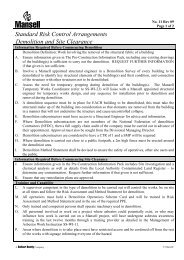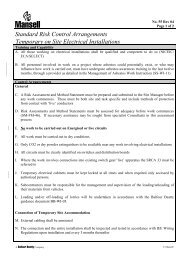Standard Risk Control Arrangements Roof Work/Working at Height
Standard Risk Control Arrangements Roof Work/Working at Height
Standard Risk Control Arrangements Roof Work/Working at Height
You also want an ePaper? Increase the reach of your titles
YUMPU automatically turns print PDFs into web optimized ePapers that Google loves.
a<br />
SM-WI-42-09<br />
No. 20 Rev 06<br />
Page 1 of 2<br />
<strong>Standard</strong> <strong>Risk</strong> <strong>Control</strong> <strong>Arrangements</strong><br />
<strong>Roof</strong> <strong>Work</strong>/<strong>Work</strong>ing <strong>at</strong> <strong>Height</strong><br />
(<strong>Work</strong>ing On <strong>Roof</strong>s Gives Rise to A Substantial Number of F<strong>at</strong>al and Serious Accidents Each Year, In Fact 1 In 5 Construction De<strong>at</strong>hs Occur In <strong>Roof</strong> <strong>Work</strong>s)<br />
Training and Capability<br />
A. All oper<strong>at</strong>ives must be trained in the <strong>Risk</strong> Assessment and Method St<strong>at</strong>ement, and in the use of the<br />
required PPE<br />
B. All oper<strong>at</strong>ives must be competent<br />
<strong>Control</strong> <strong>Arrangements</strong><br />
C. All working <strong>at</strong> height must be assessed for risk and planned in accordance with the <strong>Work</strong>ing <strong>at</strong> <strong>Height</strong><br />
<strong>Work</strong> Instruction (SM-WI-49) and comply with the relevant SRCA’s in advance of the task<br />
commencing<br />
D. A <strong>Risk</strong> Assessment and Method St<strong>at</strong>ement must be devised by competent staff to include:<br />
• The hierarchy of control for work <strong>at</strong> height, refer to SM-WI-49<br />
• <strong>Control</strong> of risk of falling, promoting collective measures ahead of personal measures to include<br />
the provision of scaffolding and handrails prior to nets (as SRCA 77) and harness<br />
• Include arrangements for dealing with emergencies th<strong>at</strong> may occur by ensuring th<strong>at</strong> a Rescue Plan<br />
is prepared which does not rely solely on the emergency services<br />
• Safe place of work, including safe access and aggress<br />
• M<strong>at</strong>erial storage and handling and loading out<br />
E. Access below or immedi<strong>at</strong>ely adjacent to any form of work <strong>at</strong> height shall be adequ<strong>at</strong>ely signed and<br />
fenced to prevent dangers to others<br />
F. Tower scaffold access points should be placed to minimise distances travelled <strong>at</strong> height<br />
G. Suitable edge protection will be provided <strong>at</strong> eaves, gables and all other open edges before work<br />
commences (as SRCA 19)<br />
H. Leading edge protection must be provided as the roof progresses in preference to other means of fall<br />
prevention<br />
I. All fragile m<strong>at</strong>erial or floor openings (roof lights, lift openings, slab edges etc.) must be protected<br />
against falls of persons or m<strong>at</strong>erials by signing and covering with non-fragile m<strong>at</strong>erials, or by being<br />
adequ<strong>at</strong>ely fenced off<br />
J. Fragile roofs and roofs with fragile rooflights shall only be accessed under a Permit to <strong>Work</strong><br />
(SM-FM-23)<br />
K. <strong>Roof</strong> sheets stored <strong>at</strong> roof level must be safely stacked and secured so they will not move in high<br />
winds<br />
L. Walking along the line of roof bolts above the purlins is forbidden<br />
M. On fragile roofs, crawling boards must be provided - being <strong>at</strong> least 600 mm wide, secured to prevent<br />
movement and fitted with handrails<br />
N. All permanent parapets and guardrails must be visually inspected before each use<br />
A Balfour Be<strong>at</strong>ty Company<br />
© Mansell
a<br />
<strong>Standard</strong> <strong>Risk</strong> <strong>Control</strong> <strong>Arrangements</strong><br />
SM-WI-42-09<br />
No. 20 Rev 06<br />
Page 2 of 2<br />
O. All temporary guardrails or protection to fragile m<strong>at</strong>erials or openings must be inspected before work<br />
commences and <strong>at</strong> 7 day intervals, with a record being kept in the Inspection Register (SS-FM-17)<br />
P. Parapet walls must not be used as a working pl<strong>at</strong>form<br />
Q. Hot works shall be controlled by a Hot <strong>Work</strong> Permit (SS-FM-11)<br />
R. All rooftop outlets and vents, shall be identified and adequ<strong>at</strong>e control measures taken e.g.:<br />
• Local ventil<strong>at</strong>ion<br />
• PPE<br />
S. Access using a running line should only be used as a last resort. If no safer altern<strong>at</strong>ive exists and the<br />
oper<strong>at</strong>ion can be carried out safely then:<br />
• There must be evidence th<strong>at</strong> the inertia reel being used is suitable for the applic<strong>at</strong>ion being<br />
carried out<br />
• There must be evidence th<strong>at</strong> the running line has been formally inspected within the last 12<br />
months<br />
• There must be evidence th<strong>at</strong> the harness/lanyard and any inertia real being used, has been<br />
formally inspected within the last 3 months<br />
• The harness/lanyard/inertia reel must be inspected before use<br />
Other Local <strong>Control</strong> <strong>Arrangements</strong><br />
A Balfour Be<strong>at</strong>ty Company<br />
© Mansell


